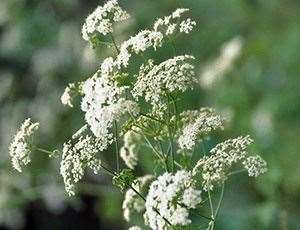Field Guide  Weed Management
Weed Management  Poison Hemlock
Poison Hemlock
Poison Hemlock (Conium maculatum L.)
Crop Impacts: Grazing areas and livestock
 | |
About Poison Hemlock:Poison Hemlock is a biennial plant, which means that it will last for 2 years and spreads by the movement of seeds. This plant is very dangerous to all humans and animals. Grazing livestock in infested fields are more likely to be poisoned in early spring and early autumn. The roots in the spring are more harmful; however, late in the year every part of the plant is very detrimental to ones health. The entire plant has a yellow, oil sap that is poisonous and is more potent in the leaf of the Poison Hemlock plant. This plant is native to Europe and has now contaminated all of North America Family: Parsley Family (Apiaceae)   
Poison hemlock Scouting and Prevention:When you are on the lookout for Poison Hemlock, it is typically found along roadsides, banks of streams, fields and woods. It grows to be 3 to 6 feet tall with a very long, white root that is typically unbranched. In the late summer it shows small white flowers and consistently has leaves and stems that are hollow, purple-spotted and smooth. Poison hemlock Control:The best way to take control of Poison Hemlock is to repeatedly mow with a closed mower, or pull it out and destroy the remains that you took out of the ground. It is important when removing the plant by hand that you remove the entire root to decrease the chance of regrowth. Repetitive cultivating or plowing of newly germinated plants will stop the establishment of Poison Hemlock. You may also be able to spot treat on seedling or small rosettes of Poison Hemlock with herbicides. The suggested herbicides to use would be 2,4-D, triclopyr, and glyphosate. Latin / Alternative Poison Hemlock names:Additional Poison Hemlock Resources
|
http://www.omafra.gov.on.ca/english/crops/facts/info_poisonhemlock.htm
http://www.library.illinois.edu/vex/toxic/phemlock/phemlck.htm
http://novascotia.ca/museum/poison/?section=species&id=78
http://www.ipm.ucdavis.edu/PMG/PESTNOTES/pn74162.html